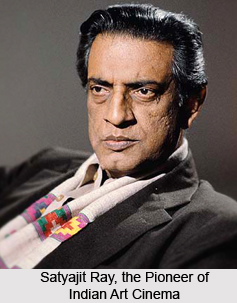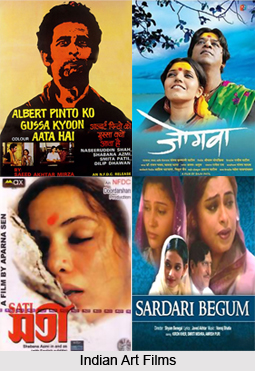 Indian art cinema differs sharply from popular films which are more commonly known as the commercial flicks. The conceptual notion of art cinema though differs from being one of the fuzziest to one of the contradictory topics ever touched upon. They are realistic, often ethnographic, and they seek to capture important aspects of Indian reality. By and large, they avoid glamour and glitz and use cinema as an artistic medium capable of exploring important areas of Indian experience.
Indian art cinema differs sharply from popular films which are more commonly known as the commercial flicks. The conceptual notion of art cinema though differs from being one of the fuzziest to one of the contradictory topics ever touched upon. They are realistic, often ethnographic, and they seek to capture important aspects of Indian reality. By and large, they avoid glamour and glitz and use cinema as an artistic medium capable of exploring important areas of Indian experience.Features of Indian Art Cinema
Indian art cinemas are usually low budget and are shown at international film festivals. The Indian art movies, understandably, do not attract the huge audiences that the popular films do. Often many regional films are made, which do not receive pan-Indian exposure. In terms of the commitment to serious cinema, to making cinema a significant medium of artistic communication, to eschewing the vulgarities and crudities often associated with Indian popular cinema, artistic filmmakers differ significantly from their counterparts in popular cinema. Art is mimesis, according to Aristotle, which is nourished by the concepts of twice placed reality. Cinema is the reel adaptation of the real. Discourses of the art house cinema have obviously two poles: as mode of narration and as institution.
Inception of Indian Art Cinema
 When one talks of art movies in India the first name that comes up is Satyajit Ray. This is because he was primarily responsible for fashioning this genre and gaining international recognition for it. His film Pather Panchali, made in 1955, was the first such film. In a poll conducted in 1992 by the magazine Sight and Sound, Pather Panchali was voted one of the ten greatest films of all time. Indian art films offer a striking contrast to Indian popular films. They use understatement effectively, something totally absent in popular films. There is a visual lyricism and a deep humanism which are intensely satisfying. Satyajit Ray made a number of significant films in the same moulds that have won international acclaim. His work provides a sense of the preoccupations of artistic cinema and how they differ from popular cinema. Satyajit Ray is generally regarded as India's greatest filmmaker and, along with Jean Renoir and Vittorio de Sica, he is rated among the great masters of humanist cinema.
When one talks of art movies in India the first name that comes up is Satyajit Ray. This is because he was primarily responsible for fashioning this genre and gaining international recognition for it. His film Pather Panchali, made in 1955, was the first such film. In a poll conducted in 1992 by the magazine Sight and Sound, Pather Panchali was voted one of the ten greatest films of all time. Indian art films offer a striking contrast to Indian popular films. They use understatement effectively, something totally absent in popular films. There is a visual lyricism and a deep humanism which are intensely satisfying. Satyajit Ray made a number of significant films in the same moulds that have won international acclaim. His work provides a sense of the preoccupations of artistic cinema and how they differ from popular cinema. Satyajit Ray is generally regarded as India's greatest filmmaker and, along with Jean Renoir and Vittorio de Sica, he is rated among the great masters of humanist cinema.Prominent Indian Art Films
Today, art movies in India no longer differ from the mainstream films in popularity. The audiences today look out for good films rather than popular or serious films. Hence while a multi-starrer Indian movie bombs at the box office, a film like Aamir is much appreciated by the cine goers. Thodasa Roomani Ho Jayen is another milestone depicting the tale an unmarriageable ugly girl. Hu Tu Tu exposes the politicians while Sookha is a realistic depiction of communal riots, politics and bureaucracy. Sushil Rajpal's Antardwand is another acclaimed film in this genre which portrays a real life experience. Kalpana Lazmi's Rudaali brilliantly presents the life and hardships of a woman who publicly express grief of family members who are restricted to display emotion owing to social status. Adoor Gopalakrishnan's film, Rat Trap (1981) has won many prestigious awards and in his film Face to Face (1984), Gopalakrishnan explores the theme of self and modernization, this time taking a different angle. Once again the style of the film follows the neo-realistic tradition. Other famed art movies of Bollywood include Ardh Satya, Suraj Ka Saatva Ghoda, Rajiv Patil's Jogwa (Marathi) and Aparna Sen's Sati (Bengali), Albert Pinto Ko Gussa Kyoon Aata Hai, Ankur, Parzania, Maya Darpan, Sardari Begum, Utsav, Ek Din Achanak, Ek Doctor Ki Maut and many more.
For more, visit the link below: